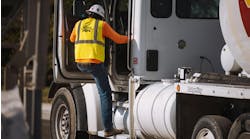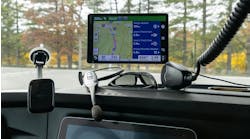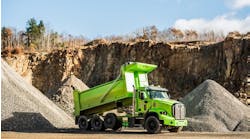Canada is planning a soft rollout of its quickly approaching electronic logging device (ELD) rules in late spring that will start with an enforcement focus on education and awareness, according to Transport Canada. While there won’t be immediate penalties for fleets and drivers who don’t comply with the new rules, Canadian and border-crossing U.S. fleets are running out of time to create an ELD plan.
Like the U.S. did in recent years, Transport Canada is moving to require most commercial drivers use ELDs to track their hours of service, governed by rules similar to the U.S. regulations.
Fleets that haul internationally likely have ELDs already. But a U.S.-approved ELD might not work in Canada. Unlike in the U.S., where the Federal Motor Carrier Safety Administration (FMCSA) had ELD providers self-certify and register third-party devices, the Canadian government is doing the certifying. The ELD mandate takes effect on June 12, but as of mid-March, no ELD has been certified yet in Canada. Despite this, it is not slowing down the nation’s push for carriers to be ready.
“As Minister of Transport, I am firmly committed to this timeline — these devices will further strengthen road safety in Canada,” Omar Alghabra, nations’ minister of transportation, said earlier in March. “At the same time, the impact of COVID-19 on commercial vehicle operations has been unprecedented and must be acknowledged. As such, with the support of provinces and territories, and in consultation with industry, we will work together on the successful and effective implementation of a progressive enforcement period. This will give sufficient time for industry to obtain and install certified ELDs without penalty as of June 12, 2021. Early enforcement measures will consist of education and awareness.”
Telematics companies on both sides of the border are also encouraging fleets to have a plan to start implementing ELDs to have enough time for installation and training.
“Regardless of if you are new to ELDs or have utilized ELDs under the U.S. mandate, it is important to understand where your ELD provider is in the certification process and if your current ELDs will be compliant by the deadline,” Scott Sutarik, Geotab’s VP of commercial vehicle solutions, told FleetOwner. “It is also important to note that given how cost and time-intensive the mandate is, many U.S.-certified ELD providers may not apply for Canadian certification. Because of this, it is even more important to understand if the provider of choice will be able to offer a compliant solution for your fleet.”
But Geotab, which is based in Ontario and provides telematics to more than 2 million connected vehicles across the globe, has found similar ELD requirements in the U.S. and Canada, Sutarik said. “These requirements include, but are not limited to, engine synchronization, GPS tracking, automatic capture drive time, on-screen display, and more.”
But there are different requirements in the two nations. “Since these rules vary, carriers should look at choosing an ELD vendor that supports both the Canadian HOS rules completely and is committed to achieving third-party certification,” Sutarik advised. “Geotab already has a Canadian ruleset available for the Geotab ELD solution and is committed to working towards fulfilling compliance for the Canadian ELD mandate.”
Geotab’s ELDs are prepared to meet both nations’ requirements, he continued. The transportation technology company’s ELDs are already capable of adjusting and displaying the correct log formatting on each side of the border.
Data opportunity
An important part of ELDs is not just about compliance, according to Frank Stowers, product manager for Trimble Transportation. He said the technology is “an opportunity to make a tangible difference on a fleet’s performance.”
“The rich amount of driver data provided by ELDs can help provide insights into driver and vehicle performance, empowering fleets to optimize available driver hours, proactively spot potential compliance issues and integrate driver and vehicle information with key back-office maintenance, dispatch and safety systems,” Stowers told FleetOwner.
By electronically capturing hours-of-service data, he said, fleets can also pair available capacity with freight to reduce empty miles, backhauls and improve driver efficiency. This can ultimately result in enhanced shipper and carrier collaboration and a more connected transportation supply chain. But getting those high-tech results “involves more than just a flip for the switch,” Stower said.
Trimble, which has been a transportation technology provider for more than 40 years, is using what it learned during the U.S. conversion to ELD requirements late last decade. In 2019, Stowers said the company helped many customers switch from paper logs and automatic onboard recording devices (AOBRDs).
“A change of this magnitude is likely to impact workflows throughout a fleet and a successful transition largely depends on how well a fleet is able to manage this change,” he said.
Trimble is encouraging fleets to prepare for the change with three key suggestions:
Train drivers and back-office personnel on both the in-cab and back-office components of the platform;
Update policies and procedures to ensure they are aligned with the regulatory aspects of the ELD mandate, including on topics such as off-duty use of trucks (also known as personal conveyance) and editing of driver records;
Understand how enforcement will work, which includes reviewing ELD-related information in the North American Out-of-Service (OOS) Criteria. This details the pass/fail criteria for all vehicle inspections so that fleets and drivers know what may put them at risk of being out of service.
Preparing the whole team
Aditi Dugar, senior project manager for Samsara, also suggested getting everyone at a fleet “on the same page” as it creates its ELD conversion plan. “Complying with the mandate isn’t just about procuring a device, it’s about preparing your entire organization to change their compliance workflows, which will take time and planning,” she told FleetOwner. “ELDs can generate a lot of valuable data; fleets can use this as an opportunity to implement new workflows that increase efficiency across their entire operations.”
She said that some Samsara customers have used ELDs to digitize recordkeeping and audit paychecks; others used ELD data to streamline dispatch operations and reduce fuel costs. But, Dugar noted, there is a learning curve. “Getting used to managing HOS regulations and roadside inspections with an electronic system can be a challenging shift from paper logs,” Dugar said. “Find an ELD provider early who already offers support for Canada HOS and electronic logs transfers and can help ease you through the mandate transition.”
Canadian fleets planning to use ELDs for the first time will need to work out an installation plan for the devices. “Installation time depends heavily on the size, location, and type of fleet that you have,” Dugar explained. “Thinking through details such as who will be installing those devices, what kind of vehicles you’re installing them in, and what mobile devices drivers can use to record drive time, will all be very important.”
Samsara, an Industrial IoT company with 20,000 worldwide customers, is suggesting fleets start with a pilot program before rolling out a new ELD system to all vehicles. “Select a small group of drivers who know the needs of your organization, have the trust of their fellow drivers, and are willing to give honest feedback,” Dugar said. “Let them use the system for a few weeks and carefully note any pain points, best practices, or suggestions so that you can adjust your larger implementation and training strategy appropriately.”
COVID effect
Transport Canada first announced its plans for ELD requirements in 2019. While COVID-19 has possibly slowed some of the device certifications, the government isn’t letting the international pandemic move the June 12 deadline. Even if that deadline will first focus more on education and awareness than penalties for noncompliance.
“I’m confident this approach will ensure the safe and efficient operation of commercial carriers by providing flexibility to commercial operators, while also maintaining the safety benefits for Canadians,” Alghabra, the transportation minister, said. “Given the benefits provided by electronic logging devices, it’s important for industry to outfit as many of their commercial vehicles with electronic logging devices as soon as reasonably possible. Truckers and other commercial operators deserve our thanks and appreciation for delivering essential services to Canadians — without them, we can’t beat this pandemic.”
While the pandemic has reminded the general public about the importance of the trucking industry, Geotab’s Sutarik said it also highlighted the importance telematics.
“While there is potential to leverage telematics data for a variety of reasons such as route optimization, increased safety and more, COVID-19 has highlighted the need for many organizations to leverage telematics data to help elevate the understanding of how a business is operating and recovering,” he said. “The data processed through telematics can be used to help make higher-level business decisions which are especially important in this current landscape, such as: What is my utilization rate? Are there areas that are hurting or areas that are at capacity? And much more.”




